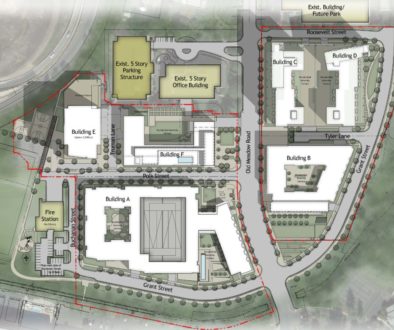Development Regulations & Zoning Basics
You just purchased your first home and you are so excited! It is a fixer-upper but you don’t care because it is all yours. You already have grand plans for this little house and one of the plans is to add an addition to the house to provide you with a master bedroom fit for royalty. You want the master bedroom to be extremely large, include a huge master bathroom and a monsterous walk-in closet big enough to fit a family. So you call up a contractor and tell him your wonderful plans for your new home, and the contractor stops you mid-dream I mean mid-sentence to say will all that put you over your lot coverage and where do you plan on putting that addition we need to make sure that you do not encroach into the setbacks?
You take the phone away from your ear to look at the phone puzzled then gentle place it back to the side of your head and say, “Lot coverage and encroaching into setbacks?” The contractor chuckles and says, “Yes did you tell yoru realtor your ideas for this house and didn’t they go over the development standards for the zone district with you?” You then say, “Zone district? “Development standards?” The contractor then sighs and says, “Houston we may have a problem.”
You may be asking what is the problem shouldn’t this person be able to build whatever they want and however they want on their property? The answer to that is an outstanding NO! Each parcel of land within a municipality has to comply with the Zoning Ordinance which is law for the jurisdiction. The zoning ordinance is written regulation and law that defines how property in specific geographic zones can be used (to obtain more information on this check out Zoning Basics blog). To add the zoning ordinance will provide you with the development standards for a specific zoning district. Keep reading to get the break down of development regulations.
Development Standards
First things first, you will see me go interchangeable between development standards, development regulations, and zoning regulations. Depending on your jurisdiction one of the phrases will be used but they all represent the same thing, which generally includes:
- Setbacks
- Lot Coverage / F.A.R. (Floor Area Ratio)
- Density
- Lot Size ( lot width/lot depth and gross and net acreage)
- Building Height
You may be stating I have no clue as to what each of these things are? No worries, I will break each one down and provide an example so you can have understanding and be empowered.
Setbacks
In relation to land use and zoning a setback is the minimum distance which a building or other structure must be set back from a street, roadway, or property line. Setbacks are building restrictions imposed on property owners. Local governments create setbacks through ordinances and Building Codes, usually for reasons of public policy such as safety, privacy, and environmental protection. I like to tell customers that the setback area is a non-buildable area and if they build in that area it is deemed as an encroachment aka violation because they are not complying with municipal law. And we all know what happens when you don’t follow the law you get in trouble.
Typically there are five setback requirements which are front yard, rear yard, side yard, street side yard and landscape setbacks. Please note that some jurisdictions have additional setbacks that can be very complicated, but for the purposes of this blog we will keep it basic.
Front Yard Setback
The front yard setback will be located in the front yard of your property and a good indication of the front yard is generally determined by two things: (1) the orientation of the front of your house and (2) the front of your house will be fronted by a street. Now there is an exception to this when your property is located on a corner lot which is fronted by two roadways. If this occurs then you will need to check with your jurisdictions planning department or read the definitions section of the Zoning Ordinance to determine what the jurisdiction considered to be the front yard for a corner lot. For the jurisdictions I have worked for if your property is fronted by two streets then the side of your property line that abuts the street and is the shortest will be the front yard the other side will be considered your street side yard setback. But as I said you will need to check with your applicable planning department and/or zoning ordinance.
Okay, but let’s say your property is situated between two houses; is therefore, not the corner lot, the front yard setback will be the minimum distance between the edge of your front property line and where the primary residence/structure is or will be built.
Rear Yard Setback
The rear yard property line is the line most opposite of your front yard property line. Thus, the rear yard setback will be the minimum distance between the edge of your rear property line and where the primary residence/structure is or will be built. Please note that for some jurisdictions if an access easement, street right-of-way line, or alley extends into or through a rear yard, the measurement shall be taken from the nearest point or centerline of the access easement right-of-way line; or alley. To know for sure you will need to contact your local planning department or read the definition section of the zoning ordinance.
Side Yard Setback
The side yard is the area between the primary residence or structure and the side lot line. It will extend from the front yard to the rear yard. Thus, the side yard setback will be the minimum distance between the edge of your side yard property line and where the primary residence/structure is or will be built.
Street Side Yard Setback
The street side yard setback will be taking from the side lot line of a corner lot that is adjacent to a street. Thus, the street side yard setback will be the minimum distance between the edge of street side yard property line and where the primary residence/structure is or will be built.
Landscape Setback
The landscape setback is identical to a land use or zoning setback in that it is an area that is unbuildable, however, the difference lies in that in this area landscaping and its appurtenances shall be installed. Reasons for a landscape setback vary, but generally where a non residential use such as a shopping plaza will abut a residential subdivision a landscaping setback will be required to aid in noise pollution, light and glare spilling over into residences backyards and obscene views to and from the commercial use.
Please note that only true way to find your property’s property lines are to hire a land surveyor. A land surveyor will be able to survey your property to determine the exact locations of your front, side, street side, and rear property lines so you can measure your setbacks properly.
Setbacks will be expressed in feet and may look like front yard setback is 20’, rear yard setback is 25’ and side yard setbacks are 5’ and street side yard setback is 10’ .
Lot Coverage
Lot Coverage is the size of the footprint(s) of a building(s) and/or structure(s) on a lot divided by the size of the parcel, expressed as a decimal number or percentage. The lot coverage is used in calculating the intensity of use of a parcel for development project. For example a property that is zoned R1-6 (Urban Residential, 6,000 square foot lot) may have a lot coverage of 40%. Therefore, that means that 40 percent of the lot can be built on. That generally will include anything under a roof. So the primary residence or structure, accessory dwelling units, accessory detached structures which can include ramadas, covered canopies, and gazebos. To get specifics on this contact your local planning department.
Floor Area Ratio (F.A.R.)
F.A.R. is the measurement of a building’s floor area in relation to the size of the lot/parcel that the building is located on. FAR is expressed as a decimal number, and is derived by dividing the total area of the building by the total area of the parcel (building area ÷ lot area). FAR is an effective way to calculate the bulk or mass of building volume on a development site, and is often used in conjunction with other development standards such as building heights, lot coverage and lot area to encourage a community’s desired arrangement and form of development. In this context, higher FARs indicate greater building volume.
Density
Density is synonymous with dwelling units per acre; thus, is a development standard that is associated with residential projects/subdivisions. The dwelling units per acre is an estimation of how many residential houses will be permitted in each acre. Each residential zone district will have varying degrees on how many residences will be allowed per acre. For instance in the R1-6 zoning district 10 through 14 dwelling units may be allowed in one acre but in a more rural zone district like RR-45 (Rural Residential, 45,000 square foot lot) 1-3 residences will be allowed in an acre. To know what density your zoning district permits contact your local planning department or read your local zoning ordinance.
Lot Size
Lot size is pretty self explanatory right? The answer is yes, its the size of the lot in square feet and acres. But many jurisdictions break this down further into lot width and lot depth. The width is the shortest distance between the side yard property lines, between the required front and rear setback lines. The lot depth is the average distance between the front and rear property lines. Lastly the lot size can be expressed in gross and net square feet and acres. Gross lot size include the property area and right-of-way (ROW), roads, alleys, easements, Net lot size excludes ROW, roads, alleys, and easements and only includes the property buildable area.
Building Height
The building height is the vertical distance between finished grade and the highest point on the building, provided that the measured elevation does not include fill or berms. Please note that you will have to contact your local planning department or read your local zoning ordinance to determine if architectural design features such as chimneys are included in the building height.
Conclusion
It is important to have a clear understanding of not only your property’s zoning district and what uses are permitted by right and with a special or conditional use permit , but it is extremely important to have a clear understanding of the development standards that are tied to the zone district. As we learned above this includes: setbacks, lot coverage, F.A.R. (floor area ratio), density, lot size, and building height. The last thing you want to do is, construct something on your property, and get cited by code enforcement due to not having a valid planning and building permit and because it wasn’t built to code. You will have a few options which include modify the structure/building to comply, tear it down or face going to court, getting fined and possible jail time. So please become familiar with your applicable zoning development standards.
Did you find this blog helpful? If so, please let me know; and if you have any comments, questions, and/or concerns please do not hesitate to contact the Friendly Neighborhood Planner.



